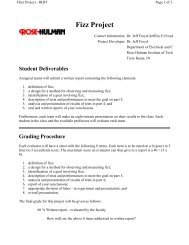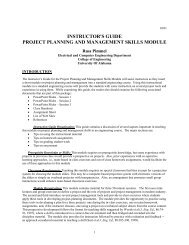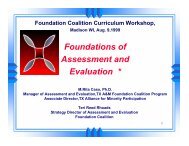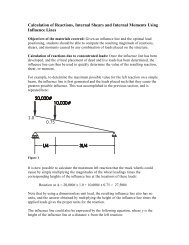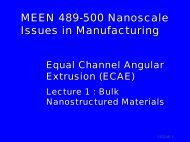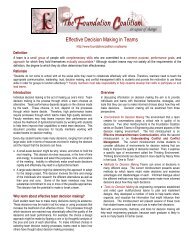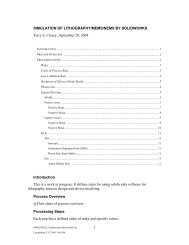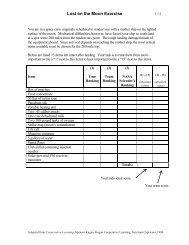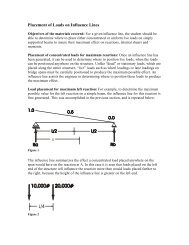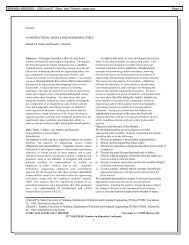Concept Inventory Assessment Tools - Foundation Coalition
Concept Inventory Assessment Tools - Foundation Coalition
Concept Inventory Assessment Tools - Foundation Coalition
- No tags were found...
You also want an ePaper? Increase the reach of your titles
YUMPU automatically turns print PDFs into web optimized ePapers that Google loves.
2001-02 <strong>Concept</strong> InventoriesWork on the following concept inventories started in October 2001.CircuitsFluid Mechanics MaterialsFaculty members interested in working with developers to developconcept inventories in the above areas should contact a developerlisted in one of the sections below.Circuits <strong>Concept</strong> <strong>Inventory</strong>Principal Developers Robert Helgeland, University of Massachusetts-Dartmouth,rhelgeland@umassd.edu David Rancour, University of Massachusetts-Dartmouth,drancour@umassd.eduCircuit Theory is usually the first course in the major for electricalengineering and computer engineering students. Part One of theCircuits <strong>Concept</strong> <strong>Inventory</strong> (CCI) will measure a student’s conceptualunderstanding of the basic properties of electricity, circuit componentsand linear time-invariant networks (DC and AC). Part Twowill address frequency domain concepts, coupled inductors, convolution,impulse response, and transform techniques.Fluid Mechanics <strong>Concept</strong> <strong>Inventory</strong>Principal DevelopersJohn Mitchell, University of Wisconsin, mitchell@engr.wisc.eduJay Martin, University of Wisconsin, martin@engr.wisc.eduTy Newell, University of Illinois at Urbana-Champaign,t-newell@uiuc.eduThe goal of the Fluids Mechanics <strong>Concept</strong> <strong>Inventory</strong> (FMCI) is toestablish a common base of fluids concepts and provide instrumentsthat could be used by faculty to evaluate the degree to whichstudents in a given program have mastered those concepts. Theinventory would be conducted in each of the fluids classes at thestart of the semester to assess the knowledge of entering studentsand at the end of the semester to assess whether students havemastered the necessary concepts. An outcome of conducting theinventory might be modifications to the curriculum and courses toensure that students obtain the necessary understanding of the basicconcepts.Materials <strong>Concept</strong> <strong>Inventory</strong>Principal Developers Richard Griffin, Texas A&M University, richard.griffin@usma.edu Steve Krause, Arizona State University, skrause@asu.eduAn instrument is being developed to measure misconceptions on materialsstructure, processing, and properties. It will be used to examine studentknowledge before and after teaching introductory materials engineeringcourses that are required by many engineering colleges. Considerable researchshows that prior misconceptions are strongly held even in the face ofgood instruction. A better understanding of "prior knowledge" can helpinstructors improve instruction in their classes.References for Further Information1. Hestenes, David, Malcolm Wells, and Gregg Swackhamer (1992). Force <strong>Concept</strong><strong>Inventory</strong>. The Physics Teacher, 30 (3), 141-1512. Hestenes, David, and Ibrahim Halloun (1995). Interpreting the Force <strong>Concept</strong> <strong>Inventory</strong>.The Physics Teacher, 33 (8)3. Halloun, Ibrahim and David Hestenes (1985). The initial knowledge state of collegephysics students. American Journal of Physics, 53(11), 1043-1055.4. Halloun, Ibrahim and David Hestenes (1985). Common sense concepts about motion.American Journal of Physics, 53(11), 1056-10655. D. L. Evans and David Hestenes, "The <strong>Concept</strong> of the <strong>Concept</strong> <strong>Inventory</strong> <strong>Assessment</strong>Instrument,” Proceedings, 2001 Frontiers in Education Conference,Reno, Nevada, 10-13 October 20016. R. J. Roedel, S. El-Ghazaly, Teri Reed Rhoads, and E. El-Sharawy, “The Wave<strong>Concept</strong>s <strong>Inventory</strong> – An <strong>Assessment</strong> Tool for Courses in Electromagnetic Engineering,“ Proceedings, 1998 Frontiers in Education Conference, November 1998,Tempe, AZ.7. Rhoads, Teri Reed, Ron J. Roedel, "The Wave <strong>Concept</strong> <strong>Inventory</strong> - A CognitiveInstrument Based on Bloom’s Taxonomy,” Proceedings, 1999 Frontiers in EducationConference, San Juan, Puerto Rico, 10-13 November 19998. Midkiff, K. Clark, Thomas A. Litzinger, and D. L. Evans, "Development of EngineeringThermodynamics <strong>Concept</strong> <strong>Inventory</strong> Instruments,” Proceedings, 2001Frontiers in Education Conference, Reno, Nevada, 10-13 October 2001One-page FIE2001 working paper: http://fie.engrng.pitt.edu/fie2001/papers/1356.pdfFIE 20001 presentation: http://foundationcoalition.org/thermo9. Richardson, Jim, and Jim Morgan, "Development of an Engineering Strength ofMaterial <strong>Concept</strong> <strong>Inventory</strong> <strong>Assessment</strong> Instrument," Proceedings, 2001 Frontiersin Education Conference, Reno, Nevada, 10-13 October 2001One-page FIE2001 working paper: http://fie.engrng.pitt.edu/fie2001/papers/1353.pdfFIE 20001 presentation: http://foundationcoalition.org/strength10. Wage, Kathleen E., and John R. Buck, “Development of the Signals and Systems<strong>Concept</strong> <strong>Inventory</strong> (SSCI) <strong>Assessment</strong> Instrument,” Proceedings, 2001 Frontiersin Education Conference, Reno, Nevada, 10-13 October 2001One-page FIE2001 working paper: http://fie.engrng.pitt.edu/fie2001/papers/1358.pdfFIE 20001 presentation: http://foundationcoalition.org/systemWhether you're just getting started or looking for some additional ideas, the <strong>Foundation</strong> <strong>Coalition</strong> would like to help you incorporate concept inventory assessmentinstruments into your engineering classes through workshops, web sites, lesson plans, and reading materials. For suggestions on where to start,see our web site at http://www.foundationcoalition.org or contact: Jeffrey Froyd at froyd@ee.tamu.edu or 979-845-7574.




